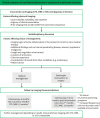Crohn's disease related strictures in cross-sectional imaging: More than meets the eye?
- PMID: 36326993
- PMCID: PMC9752301
- DOI: 10.1002/ueg2.12326
Crohn's disease related strictures in cross-sectional imaging: More than meets the eye?
Abstract
Strictures in Crohn's disease (CD) are a hallmark of long-standing intestinal damage, brought about by inflammatory and non-inflammatory pathways. Understanding the complex pathophysiology related to inflammatory infiltrates, extracellular matrix deposition, as well as muscular hyperplasia is crucial to produce high-quality scoring indices for assessing CD strictures. In addition, cross-sectional imaging modalities are the primary tool for diagnosis and follow-up of strictures, especially with the initiation of anti-fibrotic therapy clinical trials. This in turn requires such modalities to both diagnose strictures with high accuracy, as well as be able to delineate the impact of each histomorphologic component on the individual stricture. We discuss the current knowledge on cross-sectional imaging modalities used for stricturing CD, with an emphasis on histomorphologic correlates, novel imaging parameters which may improve segregation between inflammatory, muscular, and fibrotic stricture components, as well as a future outlook on the role of artificial intelligence in this field of gastroenterology.
Keywords: Crohn's disease; computer tomography enterography; cross-sectional imaging; fibrosis; intestinal ultrasound; magnetic resonance enterography; radiomics; strictures.
© 2022 The Authors. United European Gastroenterology Journal published by Wiley Periodicals LLC. on behalf of United European Gastroenterology.
Conflict of interest statement
Florian Rieder is consultant to Agomab. Allergan, AbbVie, Boehringer Ingelheim, Celgene, Cowen, Falk Pharma, Genentech, Gilead, Gossamer, Guidepoint, Helmsley, Index Pharma, Jannsen, Koutif, Mestag, Metacrine, Morphic, Origo, Pfizer, Pliant, Prometheus, Receptos, RedX, Roche, Samsung, Takeda, Techlab, Theravance, Thetis, UCB and received funding from the National Institute of Health, Helmsley Charitable Trust, Crohn's and Colitis Foundation, Rainin Foundation, UCB, Boehringer‐Ingelheim, Pliant, Morphic, BMS, 89Bio. Joseph Sleiman receives funding from Pfizer. Prathyush Chirra does not receive funding in conflict with this project. Satish E Viswanath receives funding from Pfizer. Ilyssa O Gordon does not receive and direct funding, but the Cleveland Clinic receives funding on her behalf from Celgene, UCB, GB004, Pliant, Morphic Therapeutics, and Helmsley Charitable Trust. Namita S Gandhi receives funding from Pfizer. Cathy Lu has received consultant/speaker fees from Abbvie, Janssen, Ferring, Takeda, and Fresenius Kabi. Mark E Baker Receives salary support to the Institution from Pfizer and Helmsley Charitable Trust.
Figures





Similar articles
-
Cross-sectional imaging for assessing intestinal fibrosis in Crohn's disease.J Dig Dis. 2020 Jun;21(6):342-350. doi: 10.1111/1751-2980.12881. J Dig Dis. 2020. PMID: 32418328 Review.
-
Role of artificial intelligence in Crohn's disease intestinal strictures and fibrosis.J Dig Dis. 2024 Aug;25(8):476-483. doi: 10.1111/1751-2980.13308. Epub 2024 Aug 27. J Dig Dis. 2024. PMID: 39191433 Review.
-
Assessment of Crohn's disease-associated small bowel strictures and fibrosis on cross-sectional imaging: a systematic review.Gut. 2019 Jun;68(6):1115-1126. doi: 10.1136/gutjnl-2018-318081. Epub 2019 Apr 3. Gut. 2019. PMID: 30944110 Free PMC article.
-
Systematic review: Defining, diagnosing and monitoring small bowel strictures in Crohn's disease on intestinal ultrasound.Aliment Pharmacol Ther. 2024 Apr;59(8):928-940. doi: 10.1111/apt.17918. Epub 2024 Mar 4. Aliment Pharmacol Ther. 2024. PMID: 38436124 Review.
-
Radiomics to Detect Inflammation and Fibrosis on Magnetic Resonance Enterography in Stricturing Crohn's Disease.J Crohns Colitis. 2024 Oct 15;18(10):1660-1671. doi: 10.1093/ecco-jcc/jjae073. J Crohns Colitis. 2024. PMID: 38761165
Cited by
-
Current Approach to Risk Factors and Biomarkers of Intestinal Fibrosis in Inflammatory Bowel Disease.Medicina (Kaunas). 2024 Feb 10;60(2):305. doi: 10.3390/medicina60020305. Medicina (Kaunas). 2024. PMID: 38399592 Free PMC article. Review.
-
Role of Device-Assisted Enteroscopy in Crohn's Disease.J Clin Med. 2024 Jul 4;13(13):3919. doi: 10.3390/jcm13133919. J Clin Med. 2024. PMID: 38999485 Free PMC article. Review.
-
The Diagnosis of Intestinal Fibrosis in Crohn's Disease-Present and Future.Int J Mol Sci. 2024 Jun 25;25(13):6935. doi: 10.3390/ijms25136935. Int J Mol Sci. 2024. PMID: 39000043 Free PMC article. Review.
-
Imaging of Strictures in Crohn's Disease.Life (Basel). 2023 Nov 29;13(12):2283. doi: 10.3390/life13122283. Life (Basel). 2023. PMID: 38137884 Free PMC article. Review.
-
Changing paradigms in management of inflammatory bowel disease.United European Gastroenterol J. 2022 Dec;10(10):1044-1046. doi: 10.1002/ueg2.12347. Epub 2022 Dec 5. United European Gastroenterol J. 2022. PMID: 36468779 Free PMC article. No abstract available.
References
-
- Ding NS, Yip WM, Choi CH, Saunders B, Thomas‐Gibson S, Arebi N, et al. Endoscopic dilatation of Crohn's anastomotic strictures is effective in the long term, and escalation of medical therapy improves outcomes in the biologic era. J Crohns Colitis. 2016;10(10):1172–8. 10.1093/ecco-jcc/jjw072 - DOI - PubMed
Publication types
MeSH terms
Grants and funding
LinkOut - more resources
Full Text Sources
Medical

